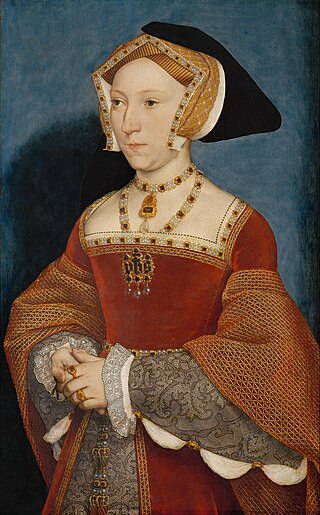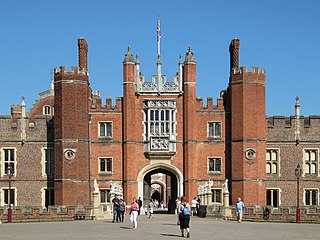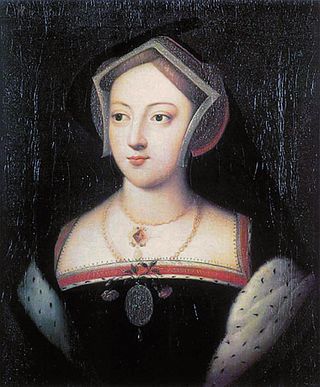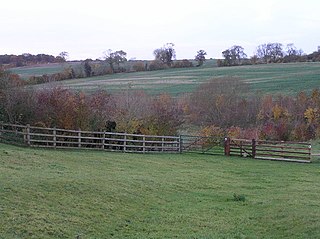
Anne Boleyn was Queen of England from 1533 to 1536, as the second wife of King Henry VIII. The circumstances of her marriage and execution by beheading for treason, made her a key figure in the political and religious upheaval that marked the start of the English Reformation.

John Morton was an English cleric, civil lawyer and administrator during the period of the Wars of the Roses. He entered royal service under Henry VI and was a trusted councillor under Edward IV and Henry VII. Edward IV made him Bishop of Ely and under Henry VII he became Lord Chancellor, Archbishop of Canterbury and a cardinal.

Jane Seymour was Queen of England as the third wife of King Henry VIII from their marriage on 30 May 1536 until her death the next year. She became queen following the execution of Henry's second wife, Anne Boleyn, who was accused by King Henry VIII of adultery after failing to produce the male heir he so desperately desired. Jane, however, died of postnatal complications less than two weeks after the birth of her only child, the future King Edward VI. She was the only wife of Henry to receive a queen's funeral; and he was later buried alongside her remains in St George's Chapel, Windsor Castle.

Anne of Cleves was Queen of England from 6 January to 12 July 1540 as the fourth wife of King Henry VIII. Not much is known about Anne before 1527, when she became betrothed to Francis, Duke of Bar, son and heir of Antoine, Duke of Lorraine, although their marriage did not proceed. In March 1539, negotiations for Anne's marriage to Henry began, as Henry believed that he needed to form a political alliance with her brother, William, who was a leader of the Protestants of Western Germany, to strengthen his position against potential attacks from Catholic France and the Holy Roman Empire.

Hampton Court Palace is a Grade I listed royal palace in the London Borough of Richmond upon Thames, 12 miles southwest and upstream of central London on the River Thames. Opened to the public, the palace is managed by Historic Royal Palaces, a charity set up to preserve several unoccupied royal properties.

Greenwich is a town in south-east London, England, within the ceremonial county of Greater London. It is situated 5.5 miles (8.9 km) east-south-east of Charing Cross.

The Palace of Beaulieu or Newhall is a former royal palace in Boreham, Essex, England, north-east of Chelmsford. The surviving part is a Grade I listed building. The property is currently occupied by New Hall School.

Greenwich Park is a former hunting park in Greenwich and one of the largest single green spaces in south-east London. One of the Royal Parks of London, and the first to be enclosed, it covers 74 hectares, and is part of the Greenwich World Heritage Site. Surrounding the hilltop Royal Observatory and straddling the Greenwich Prime Meridian, it commands elevated views over the River Thames, the Isle of Dogs and the City of London.

The Palace of Placentia, also known as Greenwich Palace, was an English royal residence that was initially built by prince Humphrey, Duke of Gloucester, in 1443. Over the centuries it took several different forms, until turned into a hospital in the 1690s. The palace was a place designed for pleasure, entertainment and an escape from the city. It was located at Greenwich on the south bank of the River Thames, downstream from London.

St James's Palace is the most senior royal palace in London, the capital of the United Kingdom. The palace gives its name to the Court of St James's, which is the monarch's royal court, and is located in the City of Westminster in London. Although no longer the principal residence of the monarch, it is the ceremonial meeting place of the Accession Council, the office of the Marshal of the Diplomatic Corps, and the London residence of several members of the royal family.

In common parlance, the wives of Henry VIII were the six queens consort of King Henry VIII of England between 1509 and his death in 1547. In legal terms, Henry had only three wives, because three of his marriages were annulled by the Church of England. He was never granted an annulment by the Pope, as he desired, however, for Catherine of Aragon, his first wife. Annulments declare that a true marriage never took place, unlike a divorce, in which a married couple end their union. Along with his six wives, Henry took several mistresses.

The Old Royal Naval College are buildings that serve as the architectural centrepiece of Maritime Greenwich, a World Heritage Site in Greenwich, London, described by the United Nations Educational, Scientific and Cultural Organisation (UNESCO) as being of "outstanding universal value" and reckoned to be the "finest and most dramatically sited architectural and landscape ensemble in the British Isles". The buildings were originally constructed to serve as Greenwich Hospital, designed by Christopher Wren, and built between 1696 and 1712. The hospital closed in 1869 and so between 1873 and 1998 the buildings were used as a training establishment for the Royal Naval College, Greenwich. The site is now managed by the Greenwich Foundation for the Old Royal Naval College, established in 1997 to conserve the buildings and grounds and convert them into a cultural destination.
Events from the 1530s in England.

Mary Boleyn, also known as Lady Mary, was the sister of English queen consort Anne Boleyn, whose family enjoyed considerable influence during the reign of King Henry VIII.
Elizabeth Anna Norton is a British historian specialising in the queens of England and the Tudor period. She obtained a Master of Arts in archaeology and anthropology from the University of Cambridge, being awarded a Double First Class degree, and a master's degree in European archaeology from the University of Oxford. She is the author of thirteen non-fiction books.

The mistresses of Henry VIII included many notable women between 1509 and 1536. They have been the subject of biographies, novels and films.

The Boleyn family was a prominent English family in the gentry and aristocracy. They reached the peak of their influence during the Tudor period, when Anne Boleyn became the second wife and queen consort of Henry VIII, their daughter being the future Elizabeth I.

Robin Hood's Larder was a veteran tree in Sherwood Forest that measured 24 feet (7.3 m) in circumference. The tree had long been hollow and is reputed to have been used by the legendary outlaw Robin Hood and others as a larder for poached meat. It was badly burnt by fire in the late 19th century and again in 1913. The tree fell in a gale in 1961 and no trace of it remains.

The Queen's Oak was a tree located near Potterspury in Northamptonshire. It is traditionally the site of the first meeting between Elizabeth Woodville and her future husband, Edward IV. The tree was badly burnt in 1994 and died in 1997.

Queen Elizabeth's Oak was a tree in the grounds of Hatfield House, Hertfordshire, England. Elizabeth I is said to have been sitting beneath the tree when she was told of her accession to the throne in 1558. The tree was visited by Queen Victoria and Albert in 1846 and they were presented with a branch and an acorn from it as a memento. The tree had deteriorated by the early 20th century and its remains were removed in 1978. A replacement oak was planted on the site by Elizabeth II in 1985.



















